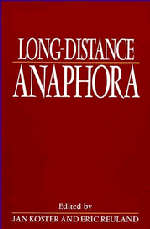Book contents
- Frontmatter
- Contents
- List of contributors
- Preface
- 1 Long-distance anaphora: an overview
- 2 Containment and connectedness anaphors
- 3 Long-distance reflexives and the typology of NPs
- 4 Contextual determination of the anaphor/pronominal distinction
- 5 On the interaction between antecedent-government and binding: the case of long-distance reflexivization
- 6 Binding in Polish
- 7 Anaphors in binary trees: an analysis of Czech reflexives
- 8 Latin long-distance anaphora
- 9 Prepositions, binding and θ-marking
- 10 Locality, parameters and some issues in Italian syntax
- 11 Long-distance binding in Finnish
- 12 The primacy condition of anaphora and pronominal variable binding
- 13 The local nature of the long-distance reflexive in Chinese
- 14 Anaphors and logophors: an argument structure perspective
- References
- Index
6 - Binding in Polish
Published online by Cambridge University Press: 01 June 2011
- Frontmatter
- Contents
- List of contributors
- Preface
- 1 Long-distance anaphora: an overview
- 2 Containment and connectedness anaphors
- 3 Long-distance reflexives and the typology of NPs
- 4 Contextual determination of the anaphor/pronominal distinction
- 5 On the interaction between antecedent-government and binding: the case of long-distance reflexivization
- 6 Binding in Polish
- 7 Anaphors in binary trees: an analysis of Czech reflexives
- 8 Latin long-distance anaphora
- 9 Prepositions, binding and θ-marking
- 10 Locality, parameters and some issues in Italian syntax
- 11 Long-distance binding in Finnish
- 12 The primacy condition of anaphora and pronominal variable binding
- 13 The local nature of the long-distance reflexive in Chinese
- 14 Anaphors and logophors: an argument structure perspective
- References
- Index
Summary
Introduction
Recent research shows that anaphoric elements pattern in at least two different ways: some of them obey a strict locality condition, and others do not. In the first case an anaphor requires an antecedent in a local domain and in the second case the binding domain is extended. Local domains and their extensions may vary from language to language. The goal of this chapter is to present a description of binding domains for Polish anaphors.
Polish is a Slavonic language. The group of Slavonic languages has hardly been investigated in the light of the binding theory developed in Chomsky (1981). Some of the facts to be discussed will be unexpected from the perspective of current theory. I trust that the conditions under which they can be accommodated will shed light on the nature of parametrization.
Section 2 of this chapter presents Polish binding facts. Section 2.1 gives some general background about Polish, and 2.2 about the Polish anaphoric/pronominal system. Anaphoric relations within simplex clauses are described in 2.3 and anaphoric relations across clause boundaries in 2.4 (clauses with tenseless complements) and 2.5 (clauses with participial complements). The NP as a binding domain will be discussed in 2.6.
Section 3 of this chapter discusses the binding theory for Polish. In 3.1 binding domains for anaphors are investigated, and in 3.2 domains for pronominals. In the last section (3.3) it will be shown how the binding theory applies to Polish.
- Type
- Chapter
- Information
- Long Distance Anaphora , pp. 137 - 150Publisher: Cambridge University PressPrint publication year: 1991
- 6
- Cited by



